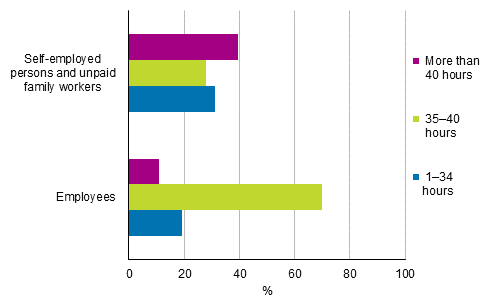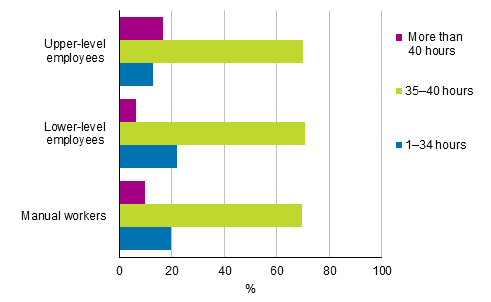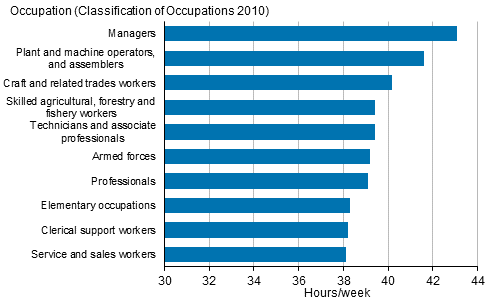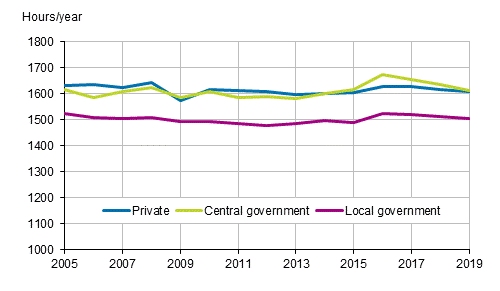3 Working hours in 2019
3.1 Working hours have changed slowly
The statistical concepts of working hours are usual weekly working hours, hours actually worked per week, and hours actually worked per employed.
Usual weekly working hours refer to an employee's normal or average weekly working hours in the main job. Regular paid or unpaid overtime is included in the usual weekly working hours of employees.
Hours actually worked per week are the number of hours employed persons have worked in the survey week. Hours actually worked per week are separately inquired as concerns the main job and secondary job. All paid or unpaid overtime hours during the survey week are also included. On the other hand, holidays, weekdays off and absences for other reasons (e.g. sickness) reduce the hours actually worked per week.
Annual hours actually worked per employed are an imputed concept, which is obtained by dividing the number of hours worked by all employed in main and secondary jobs during the year by the annual average number of employed. This produces the average hours actually worked per employed. Hours actually worked per employed are calculated in the same way for employed employees.
Working hours and hours worked fluctuate according to changes in the employment rate and in the structure of the employee population. For instance, if part-time work becomes more widespread than full-time work, the average weekly working hours will decrease. Working hours also vary by industry and occupation, as well as by employer sector. Working hours change quite slowly.
3.2 Most common usual working week is 35 to 40 hours
The vast majority of employees, 70 per cent, had usual weekly working hours in the range of 35 to 40 hours in 2019. For eleven per cent of employees usual weekly working hours were over 40 hours. For nineteen per cent of employees usual weekly working hours were under 35 hours. In this group the most common usual weekly working hours were 30 to 34 hours.
Long usual weekly working hours were clearly more widespread among self-employed persons and unpaid family workers. For 40 per cent of them, usual weekly working hours were over 40 hours. Only 28 per cent of self-employed persons and unpaid family workers had usual weekly working hours of 35 to 40. A working time of under 35 weekly hours was more common for self-employed persons (31%) than employees (19%). (Figure 16.)
Figure 16. Average usual weekly working hours of employed persons in their main job by status in employment in 2019, persons aged 15 to 74, %

When examining the usual working hours of employees by socio-economic group, differences in usual weekly working hours are most clearly visible in the share of those with long weekly working hours. For all groups, clearly the most common working hours were 35 to 40 hours per week in 2019. Seventeen per cent of upper-level employees and seven per cent of lower-level employees worked regularly over 40 hours per week. One in five lower-level employees and manual workers had short usual working hours of under 35 hours per week. Working weeks of under 35 hours were less usual among upper-level employees. (Figure 17.)
Figure 17. Average usual weekly working hours of employees in their main job by socio-economic group in 2019, persons aged 15 to 74, %

3.3 Men’s working week in full-time employment longer than women’s
In 2019, employees' average usual weekly working hours were 36.2 hours in their main job and their hours actually worked per week in their main job were 34.9 hours. Weekly working time was considerably longer for self-employed persons (including unpaid family workers) than for employees: the average for usual weekly working hours was 39.2 hours per week and hours actually worked per week were 38.3 hours. Compared to usual weekly working hours, hours actually worked per week are reduced by holidays and other absences but on the other hand, are lengthened by worked overtime hours.
As in previous years, men's usual and actual weekly working hours were longer than women’s in 2019. By contrast, both the usual and actual weekly working hours of women working part-time were slightly longer than for part-time working men. (Table 2.)
Table 2. Employees’ usual weekly working hours in their main job and hours actually worked per week in full-time and part-time work by sex in 2019, persons aged 15 to 74, %
| Usual weekly working hours, hours/week | Hours actually worked per week, hours/week | |||||
| Full-time and part-time work total | Full-time work | Part-time work | Full-time and part-time work total | Full-time work | Part-time work | |
| Both sexes total | 36.2 | 39.4 | 19.4 | 34.9 | 37.7 | 19.4 |
| Males | 37.9 | 40.1 | 18.3 | 36.7 | 38.6 | 18.4 |
| Females | 34.5 | 38.5 | 19.9 | 33.0 | 36.5 | 19.9 |
Among the occupational groups of employees in full-time employment, managers had the longest usual weekly working hours of 43.1 in 2019. In addition to managers, plant and machine operators and assemblers, and craft and related trades workers had usual weekly working hours of over 40. Correspondingly, service and sales workers had the shortest usual weekly working hours. (Figure 18.)
Figure 18. Usual weekly working hours of full-time employees in main job by occupational group in 2019, persons aged 15 to 74

3.4 Employees’ hours actually worked per employed remained almost unchanged
Employees’ hours actually worked per employed (see definition in Section 3.1) was 1,582 hours in 2019, which was 10 hours fewer than in the previous year. In the central government sector, hours actually worked per employed decreased from 2018. In the local government and the private sectors, hours actually worked per employed also declined slightly. In the central government sector, hours actually worked per employed have been longer than in the private sector since 2015. In the local government sector, hours actually worked are, in turn, clearly lower than in other sectors. (Figure 19.)
Figure 19. Annual hours actually worked per employee by employer sector in 2005 to 2019, aged 15 to 74

In 2019, the number of hours actually worked per employed was 1,471 hours among female employees and 1,694 hours among male employees. The differences in men's and women's working hours is affected by that women's work relationships are more often part-time than men's. Family leaves also shorten women’s hours actually worked more than men’s.
Source: Labour Force Survey 2019. Statistics Finland
Inquiries: Ulla Hannula 029 551 2924, Tatu Leskinen 029 551 3285, tyovoimatutkimus@stat.fi
Director in charge: Jari Tarkoma
Updated 7.5.2020
Official Statistics of Finland (OSF):
Labour force survey [e-publication].
ISSN=1798-7857. Employment and unemployment 2019,
3 Working hours in 2019
. Helsinki: Statistics Finland [referred: 19.4.2025].
Access method: http://stat.fi/til/tyti/2019/13/tyti_2019_13_2020-05-07_kat_003_en.html

